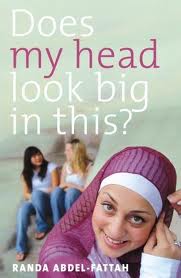Does My Head Look Big in This? by Randa Abdel-Fattah
Reviewed by Chris

Ratings Explanation
Language: A handful of swearwords.
Sexual content: Mostly talking about why Amal has committed to wait until marriage, not just for sex but even to kiss.
Adult Themes: Bigotry, cultural oppression of women.
Amal is a smart, sassy 16-year-old who loves to debate and usually has the perfect comeback when the idiots in her life speak up. She is very witty, lightening up a story that could have been heavy and moralistic. She is a “hyphenated Australian,” with Middle Eastern parents, attending a prep school with non-Muslims in Melbourne. Her personal faith prompts her to make the decision to wear the hijab, or headscarf, showing her commitment to God, full-time. Her parents are a bit worried about making this move in high school, but supportive once she expresses her commitment. At first her classmates are shocked when she appears at school in the hijab. After a few days they start asking her questions about it. She is most upset that Adam, the boy she really likes, ignores her at first, but things thaw. In fact, they become best friends, chatting on the phone while doing homework. She is committed to her religion’s teachings that sex and even kissing are only for after marriage, and she explains her feelings about Adam: “I want to be his best female friend. …I want to know he confides in me and talks to me and looks out for my opinion more than any other girls. That would be the best. The physical stuff I’ll imagine!” It is obvious that the general culture around her expects girl/boy relationships to include sex. The setting is after the Twin Towers attacks, and Amal has to deal with bigoted treatment from others. The characters include a wide variety of religious and cultural backgrounds, and the many ways they embrace or reject their differences. Some of her friends have ultra-old-fashioned ideas which are cultural rather than religious, and Amal gets involved in the conflict between the modern teen and the village mentality of her parents. All the while, she is dealing with typical teenage concerns like choosing a major, what eyeliner looks best, and whether she will fall flat on her face in the next debate.
This was a very funny book and educational for someone who has not had Muslim friends. It really highlights individuality. Amal’s arguments for saving sex for marriage are really refreshing. She points out prejudice when she is asked to speak at a forum on Islam, and she replies with something like, “How could you possibly expect me to explain terrorism?” And, “What kind of person do you think I am when you associate me with them?” I really enjoyed it and would love to read more by this author.








